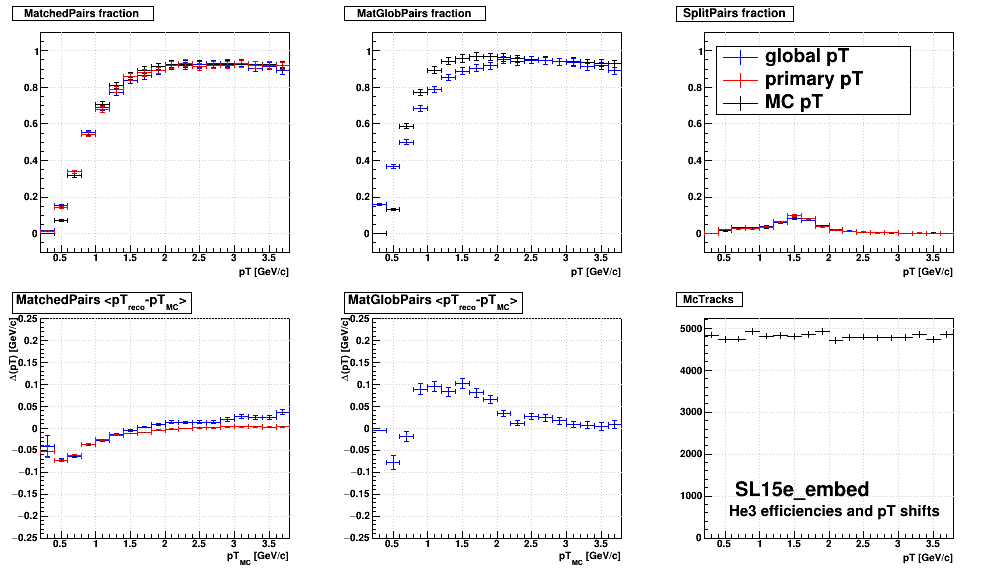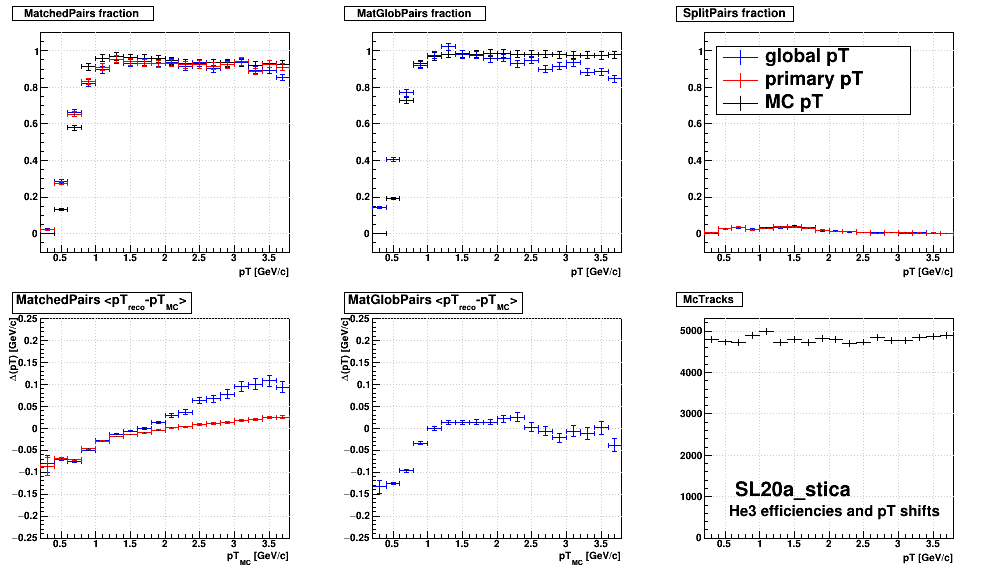- genevb's home page
- Posts
- 2025
- 2024
- 2023
- 2022
- September (1)
- 2021
- 2020
- 2019
- 2018
- 2017
- December (1)
- October (3)
- September (1)
- August (1)
- July (2)
- June (2)
- April (2)
- March (2)
- February (1)
- 2016
- November (2)
- September (1)
- August (2)
- July (1)
- June (2)
- May (2)
- April (1)
- March (5)
- February (2)
- January (1)
- 2015
- December (1)
- October (1)
- September (2)
- June (1)
- May (2)
- April (2)
- March (3)
- February (1)
- January (3)
- 2014
- 2013
- 2012
- 2011
- January (3)
- 2010
- February (4)
- 2009
- 2008
- 2005
- October (1)
- My blog
- Post new blog entry
- All blogs
He3 efficiencies (RT2561)
In an effort to take another look at RT2561 (original documentation You do not have access to view this node), I tried to have a quick look at the He3 reconstruction efficiency as a function of pT (the original issue was a dip in this efficiency in pT near 1.5 GeV/c). I went back to the oldest library I could use for a simple embedding command I had, even though it embedded He3 into 2012 pp200 data (I wasn't too worried about the background data; more concerned with the He3 results), and this turned out to be SL15e_embed (the job simply wouldn't execute in older libraries). Here is the job I ran:
For a few selected libraries, I also ran the above, but modified the production chain to include StiCA, given that only Sti is used by the original chain, and there is some possibility that StiCA does not see the same artifacts as Sti. One note is that StiCA wasn't available straight out of the box with SL15e_embed, and appears in the standard compiled library beginning with SL16g (and SL16_embed) as this is when the S&C team tackled the unfinished effort by its authors to integrate StiCA.
I created a simple macro to make plots from the resulting minimc.root trees showing a quick efficiency calculation (reconstructed He3 / simulated He3 vs. pT) for tracks that get reconstructed as primaries ("MatchedPairs", which also shows their global partners) and globals ("MatGlobPairs", regardless of whether they had a primary partner), placing no cuts on the tracks. I also noticed that the distributions changed depending on which pT was used, so I made profile plots of how pT differed between simulation and reconstruction (here I cut on |Δ(pT)|<10 GeV/c to avoid outliers throwing off the profiles), which has some surprising results. Here are some of the observations:
Notes regarding the plots: 1) The library used is shown in the bottom right of each image. 2) I multiplied the stored reconstructed pT by x2. 3) Open the images in a new tab/window to see it larger.



















-Gene
root4star -b -q -l '/afs/rhic.bnl.gov/star/packages/DEV/StRoot/macros/embedding/bfcMixer_Tpx.C(75, "/tmp/genevb/RT2561/tagpath/st_physics_adc_13044030_raw_1510005.daq", "/tmp/genevb/RT2561/tagpath/st_physics_adc_13044030_raw_1510005.tags.root", 0.2,4.0,-0.5,0.5,-60.0,60.0,100,49,100,0,"P12idpp200")'This "P12idpp200" runs the following for the production chain part:
"DbV20130212,pp2012b,StiCa,AgML,mtdDat,btof,fmsDat,BEmcChkStat,Corr4,OSpaceZ2,OGridLeak3D,VFMCE,TpxClu,-hitfilt"Generally, I ran 16 of these jobs (32-bit, unoptimized) to embed 100 He3 in 75x16 = 1200 events, so a total of 120,000 He3, all within a limited pT, η, and VertexZ range to give them a good chance of being reconstructed.
For a few selected libraries, I also ran the above, but modified the production chain to include StiCA, given that only Sti is used by the original chain, and there is some possibility that StiCA does not see the same artifacts as Sti. One note is that StiCA wasn't available straight out of the box with SL15e_embed, and appears in the standard compiled library beginning with SL16g (and SL16_embed) as this is when the S&C team tackled the unfinished effort by its authors to integrate StiCA.
I created a simple macro to make plots from the resulting minimc.root trees showing a quick efficiency calculation (reconstructed He3 / simulated He3 vs. pT) for tracks that get reconstructed as primaries ("MatchedPairs", which also shows their global partners) and globals ("MatGlobPairs", regardless of whether they had a primary partner), placing no cuts on the tracks. I also noticed that the distributions changed depending on which pT was used, so I made profile plots of how pT differed between simulation and reconstruction (here I cut on |Δ(pT)|<10 GeV/c to avoid outliers throwing off the profiles), which has some surprising results. Here are some of the observations:
- As expected, at low pT, the reconstructed pT is lower than the MC pT due to energy loss. I'm not sure why this swings the other way at higher pT, but perhaps it's where the pion assumption in tracking over-compensates for the energy loss of He3? These pT shifts are significant, at the 100 MeV/c order of magnitude.
- There always seems to be a peak in the split He3 tracks for Sti right around 1.5 GeV/c. This would only cause a dip in the efficiency if one requests there to be only a single reconstructed partner for an MC track.
- There is essentially no such peak in split He3 tracks for StiCA!
- Something changed for reconstructed He3 global pT between SL19a and SL19b (primaries seem much less affected). SL19a wasn't used in a production, but I included it here to see whether the change happened before or after SL19a was frozen.
- Something improved for low-pT He3 reconstruction efficiency in non-embedding libraries also starting in SL19b, but then also in the SL17d_embed embedding library (curiously not changed in SL18c_embed). If this was something back-ported to SL17d_embed, then this is probably not a change in reconstruction code, but a change in the simulation somewhere?
- The minimc tree also had GhostPairs and ContamPairs, but these were always at or very close to zero entries, giving no information, so I excluded them from the plots.
Notes regarding the plots: 1) The library used is shown in the bottom right of each image. 2) I multiplied the stored reconstructed pT by x2. 3) Open the images in a new tab/window to see it larger.



















-Gene
Groups:
- genevb's blog
- Login or register to post comments
